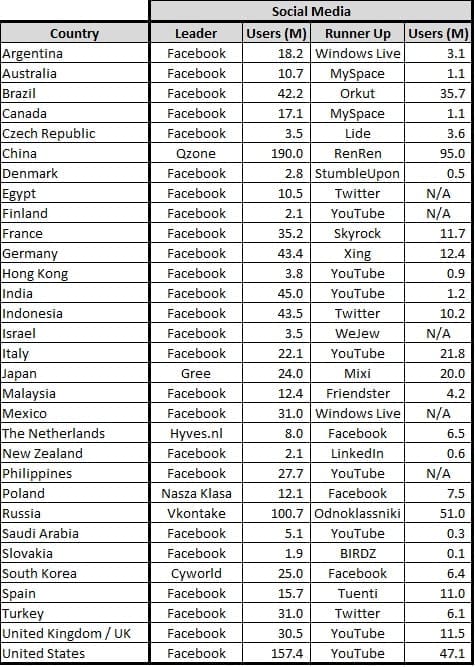If you follow SEO and Social, you already realize that social is becoming a major factor in search.
Both Google and Bing have emphasized it. Research continues to surface that further proves this is true.
Basically, if you’re in the SEO game, you HAVE to figure out social.
Okay, soapboxes aside, let’s get to the numbers
Leading Social Media Platforms by Country

Takeaways
Just as with the Search Engine numbers I shared in the previous post, there are a bunch of big findings here.
First, Facebook is truly the leader across these markets, and not by a small margin. If you didn’t already believe they’re a force to be reckoned with, just look at this table and think again.
YouTube is the closest to a second place candidate we have. That said, they still pale in adoption as compared to the top dog, Facebook.
International markets still use older platforms like Friendster and MySpace, both of which have generally fallen out of favor stateside, more than you might think. Heck, even Windows Live shows up in Mexico and Argentina as a viable player!
Local Social Media Platforms Matter
A major finding in all this effort is that local social media platforms really do matter in several countries.
- China – China has many rules, regulations, and filters surrounding the internet in general. They have their own search engine (Baidu), so why not their own social networks? Their population is large enough that they can take such liberties. If China matters to your business or for your content marketing, take a moment to understand what Qzone and RenRen have to offer.
- Japan – With such a unique, innovative culture in Japan, one would naturally expect them to have their own social networks. The leaders have pretty good market share – Gree has 24M registered users (23.7% of internet users) and Mixi has an even 20M (19.8% of internet users). With only 7.6% penetration in the Japanese user base, Facebook has a huge task ahead if they aim to be #1 in Japan.
- Russia – Russia has their own localized search engines as well, much like they have Yandex as the local search engine of choice. Facebook only has 4.5M users in Russia, so they are far behind the frontrunners and have the same challenges in growing a user base. The locals prefer their own platforms, Vkontakte and Odnoklassniki.
- South Korea – Although Facebook registers as a #2 in South Korea, local social network Cyworld enjoys nearly a 5X lead in user base. Still, the runner up has been growing there and may eventually become a true challenger to Cyworld.
- Poland – Although Facebook is on a fast growth path in Poland, they are still 5M users behind local social network Nasza Klasa. Don’t be surprised to see that service usurped in the next 1-2 years.
- The Netherlands – In another country where Facebook is sure to overtake the leader, local social networking service Hyves.nl enjoys a user base of 8M. At 6.5M, Facebook is not far behind. The number of users on both services represents significant percentages of their 15.1M Internet User population.
As far as “Leaders” in social media, these are the only examples where Facebook is not the top platform. You can see that the “Runner Up” in many countries is local as well.
Although it shows a larger number of user base in the Czech Republic for Lide than Facebook, they are closer to even with Facebook slightly ahead. The discrepancy is due to rounding. Facebook has taken the lead and isn’t looking back.
Thanks for reading! If you have questions or feedback on this post, please comment below.
DATA SOURCES
Internet World Stats Website
The WebCertain Search and Social Report 2011
Tommy Landry
Latest posts by Tommy Landry (see all)
- Local SEO Meets AEO and GEO: How AI Platforms Read Local Authority Signals - December 9, 2025
- What Is an SEO Proposal and What Should It Include? - December 2, 2025
- The Complete Guide to Dental SEO: How Dentists Can Attract More Local Patients Online - November 25, 2025




